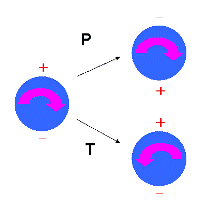|
The Electric Dipole Moment of the neutron
To date, every measurement of the neutron electric dipole moment
(EDM) has given a value of zero,
but there is a good reason to believe it is actually a very small, but non zero, value.
A non-zero electric dipole moment of the neutron (or any fundamental
particle) would be a violation of parity (P) and time-reversal (T) symmetry.
This can be explained by the following picture: if the neutron has a finite EDM,
the charge distribution is reversed under P; it is unchanged under T, but the
orientation of a particle is specified by its spin, which is unchanged under P, but reverses under T. Therefore if
the EDM is not zero then P and T are not conserved.
Assuming the combined operation CPT is invariant, then a measurement of T
violation implies CP is also violated. This has significant consequences for
cosmology. Present theories of particle physics and cosmology predict that
our Universe was formed with equal parts matter and antimatter, which should
by now have annihilated into radiation. To explain the dominance of matter,
CP violation must exist.
CP violation has been observed in accelerator experiments studying the
decays of K and B mesons, but not at a level with can explain the
matter-antimatter asymmetry of the Universe. Therefore in order to explain
why the Universe exists we need to study other CP violating systems such as
the neutron EDM. This also provides a way to test theories of new physics,
as supersymmetry (for example) predicts a neutron EDM at a level of 10-28-10-26ecm,
above the standard model prediction. Theories such as additional Higgs
fields, and left-right symmetric models also predict a neutron EDM at a
level which will be probed by new experiments.
Neutron EDM measurements have also shown that CP is conserved to a
remarkable degree by the strong interaction. This would appear to require
significant fine tuning of the relevant QCD parameter; but it can also be
explaining by a hypothetical particle, the axion, which would
effectively cancel the CP violating term in the QCD Lagrangian. Axions are
also a possible dark matter candidate.
The current limit on the neutron EDM is d<2.9×10-26ecm, set
by the nEDM experiment. This was measured at the Institut Laue-Langevin using
room temperature apparatus, by storing a large number of ultra-cold neutrons in
a storage cell in an electric and magnetic field. The Larmor spin precession
frequency was measured to a high precision for parallel and anti-parallel fields.
A shift in the precession
frequency between these two measurements, would be a sign of the neutron EDM.
A significant systematic error is caused by any drift in the magnetic field
between measurements; as
the neutron has a non-zero magnetic dipole moment, this also produces a shift in
the precession frequency. The nEDM group used atomic mercury spectrometry to
monitor the magnetic field to nanotesla precision.
By 1999 the experiment had reached the best sensitivity which could be achieved
with the apparatus, and the collaboration started design and construction of the
cryoEDM project. The Oxford group joined the project
in 2003.
|
 |
| The neutron EDM is reversed by the parity operation.
It is unchanged by time-reversal, but this reverses the spin, which
specifies the orientation, so a non zero EDM would be a violation of
both T and P symmetry. |
| |
|


